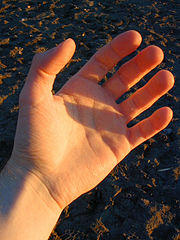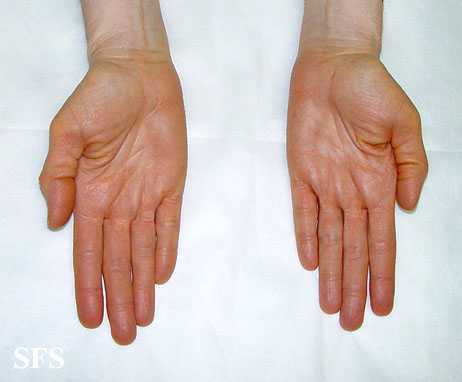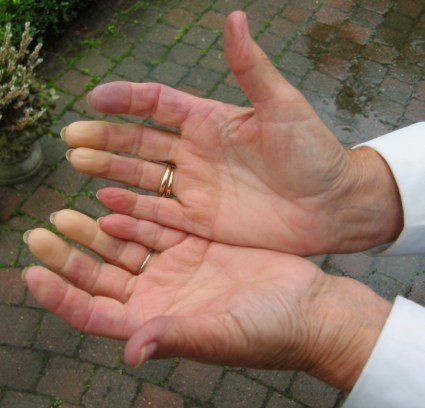Causes and Treatment of Palmar Hyperhidrosis – Sweaty Palms/Hands
What is Palmar Hyperhidrosis?
Sweaty palms, medical term palmar hyperhidrosis, refers to profuse perspiration (excessive sweating) of the palms. Palmar hyperhidrosis is one form of focal hyperhidrosis, meaning profuse perspiration affecting one area of the body. Sweaty palms may be accompanied by profuse perspiration of the feet, forehead, ckeeks, armpits (axillae) or be part of general hyperhidrosis (profuse perspiration throughout the body). Hyperhidrosis refers to profuse perspiration beyond the body’s thermoregulatory (temperature control) needs. A Greek term for hyperhidrosis is diaphoresis.

Symptoms of Palmar Hyperhidrosis
The intensity of symptoms may vary among sufferers and trigger factors should be carefully noted. Common symptoms include :
- Perspiration of the hands can vary from mild clamminess to severe perspiration resulting in dripping sweat.
- Temperature differences of palmar surface compared to surface temperature of other parts of the body may be noted.
- Sloughing (peeling) of skin may be noted in profuse perspiration.
- Episodes of profuse perspiration may be followed by periods of extreme dryness on the palmar surface.
- Hyperhidrosis often starts in puberty, and family history is often reported (4).
The secondary effects of palmar hyperhidrosis can result in both psychosocial effects as well as difficulty in undertaking certain tasks or handling equipment. Sufferers of palmar hyperhidrosis are often reluctant to partake in socially expected actions like shaking hands or touching loved ones.
The embarrassment of dealing with this condition can affect the level of interactivity in both social and work situations. Difficulties with holding objects, gripping equipment or soiling electronic devices like keyboards may affect functioning at work. Daily activities such as writing with a pen or counting cash notes is often difficult.
What Causes Palmar Hyperhidrosis?
Hyperhidrosis is either primary focal or secondary generalized (5).
1. Primary Palmar Hyperhidrosis
Focal palmar hyperhidrosis is usually localized and is referred to as primary (essential, idiopathic), meaning no obvious cause, except strong family predisposition can be found (4,5), and affected persons are otherwise healthy (4).
Sweating on other locations as feet, armpits and face may appear. Primary palmar hyperhidrosis is caused by overactivity of the sympathetic nervous system, primarily triggered by emotional causes including anxiety, nervousness, anger and fear (3). There may be a significant reduction in perspiration during sleep or sedation (3).
2. Secondary Palmar Hyperhidrosis
In secondary palmar hyperhidrosis hands sweat due to an obvious underlying disorder like:
- Infections including local infections, tuberculosis and tinea ugunium.
- Neurological disorders like peripheral autonomic neuropathy
- Frostbite
- Arteriovenous Fistulas
- Acromegaly
- Acrodynia
- Complex Regional Pain Syndromes
- Pachyonychia Congenita
- Primary Hypertrophic osteoarthropathy
- Dyskeratosis Congenita
- Blue rubber-bleb nevus
- Glomus tumor
- Secondary palmar hyperhidrosis as part of generalized hyperhidrosis due to (3,5): hormonal causes (diabetes, hyperthyroidism, thyrotoxicosis, menstruation, menopause), metabolic disorders, malignant disease (lymphoma, pheochromocitoma), autoimmune disorders (rheumatoid arthritis, systemic lupus erythrematosus), drugs like hypertensive drugs and certain classes of antidepressants (list of medications causing hyperhidrosis), chronic use of alcohol, Parkinson’s disease, neurological disorders (toxic neuropathy), homocystinuria, plasma cell disorders. Detailed list of conditions causing generalyzed hyperhidrosis.
How Sweat Glands Work
In eccrine glands, the major substance enabling impulse conduction is acetylcholine, and in apocrine glands, they are catecholamines. Body temperature is controlled by the thermoregulatory center in the hypothalamus and this is influenced not only by by core body temperature but also by hormones, pyrogens, exercise and emotions (9).
Interesting Details About Physiology of Sweating
Mechanism of Focal Hyperhidrosis

Only eccrine sweat glands that secrete odourless sweat are involved in focal hyperhidrosis (4). Apocrine glands – scent glands found mainly in axilla and genitalia – are stimulated by sex and other hormones and are not involved in focal hyperhidrosis (4). There is evidence that these patients have a reduced threshold for emotional sweating but have normal thermoregulatory processes and drug-induced sweating (6).
Investigating Palmar Hyperhidrosis
The first step in the evaluation of hyperhidrosis is to differentiate between generalized and focal hyperhidrosis. A thorough case taking and medical history is usually sufficient to diagnose palmar hyperhidrosis and any trigger factors (scheduled drugs, narcotics, chronic alcoholism).

Diagnostic criteria for primary focal (including palmar) hyperhidrosis include (4):
- Bilateral and relatively symmetric sweating
- Frequency of at least 1 episode per week
- Impairment of daily activities
- Age at onset before 25 years
- Family history
- Cessation of sweating during sleep
Tests may include:
- Hematological studies may be necessary to identify thyroid disorders (thyroid function test for T3 and T4 as well as thyroid antibodies) and diabetes (fasting blood glucose or a glucose tolerance test).
- X-rays and MRI scans will assist for diagnosing tuberculosis, pneumonia and tumors.
- Superficial electroconductivity can be monitored as any hyperhidrosis reduces skin electrical resistance.
- Thermoregulatory sweat test uses moisture-sensitive indicator powder to monitor moisture. Changes in the color of the powder at room temperature will highlight areas of increased perspiration.
Conservative Management of Palmar Hyperhidrosis
Conservative management should be coupled with prescribed treatment by a medical practitioner to reduce the symptoms.
- Counseling may be effective in managing primary palmar hyperhidrosis in cases of mental-emotional etiology.
- Trigger foods and aggravating factors should be noted if possible and relevant dietary changes should be implemented.
- Effective prevention of secondary palmar hyperhidrosis is difficult with conservative management and drug therapy or surgery may be required.
- Excessive physical activity and extremes of heat may be two trigger factors that should be avoided as far as possible.
- In cases of diabetes, a glucose controlled diet with low glycemic index may improve glucose tolerance which could assist with palmar hyperhidrosis.
- Abstinence from alcohol and narcotics is advisable if it is the causative factor for sweaty palms.
- Stimulants such as caffeine and nicotine may aggravate palmar hypehidrosis and should relevant dietary and lifestyle changes should be implemented.
- Anti-perspirant compounds like aluminum chloride can be applied on the palms to reduce moisture or palmar surfaces. Recent research on an aluminum sesquichlorohydrate foam has shown that it is effective in reducing sweat in palmar hyperhidrosis (2).
Treatment of Palmar Hyperhidrosis
Standard therapeutic protocol may differ among cases of palmar hyperhidrosis depending on medical history and underlying pathology.
- Anticholinergic drugs have a direct effect on the sympathetic nervous system although there are numerous side effects.
- Treatment should be directed at contributing factors.
- Ionophoresis involves the use of electrotherapeutic measures to reduce the activity of sweat glands.
- Botulinum injections at the affected area may be useful for its anticholinergic effects.
- Surgery should be considered if drug therapy proves ineffective. Endoscopic transthoracic sympathectomy involves resection of the sympathetic nerve supply to the affected area. This prevents nerve stimulation of the sweat gland of the palms. However surgery has a host of complications including exacerbating the problem or increasing generalized hyperhidrosis (3).
Possible Approach to Primary Palmar Hyperhidrosis
Considering the strong evidence (3, 5) that certain emotional states may trigger or aggravate focal hyperhidrosis, including sweaty palms, the first approach should take the psychological component into consideration.
The sympathetic nervous system, which triggers perspiration, may be overactive (8) in some individuals due to emotional states like anxiety, depression or stress. Counseling and stress management can therefore play an integral part in managing palmar hyperhidrosis.
This does not mean that every case of palmar hyperhidrosis is due to a psychological cause. Since most sufferers report an aggravation of symptoms with certain emotional states, it would be prudent to at least investigate how counseling, stress management, meditation and other relaxation techniques can assist a person with at least reducing the severity of the sweating. This may not be a “cure” for the condition but can be useful in controlling the extent of the palmar hyperhidrosis.
Read more on how to stop palm sweating.
References:
- Sweaty palms syndrome may run in families (universityofcalifornia.edu)
- Hyperhidrosis causes (emedicine.com)
- Diagnostic criteria for primary focal hyperhidrosis (sweathelp.org)
- Two types of hyperhidrosis: primary focal and secondary generalized (sweathelp.org)
- Hyperhidrosis pathophysiology (sweathelp.org)
- Hyperhidrois epidemiology (sweathelp.org)
- Characteristic reactions on stress by hyperhidrotic persons (sweathelp.org)
- Hölzle E. Pathophysiology of sweating. Curr Probl Dermatol. 2002;30:10-22.
- Sato K, Kang WH, Saga K, Sato KT. Biology of sweat glands and their disorders. II. Disorders of sweat gland function. J Am Acad Dermatol. 1989;20:713-726.




